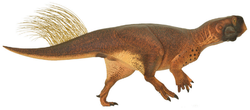| Zuniceratops | |
|---|---|
 | |
| Reconstructed skeleton | |
| Scientific classification | |
| Kingdom: | Animalia |
| Phylum: | Chordata |
| Class: | Reptilia |
| Clade: | Dinosauria |
| Clade: | † Ornithischia |
| Clade: | † Ceratopsia |
| Clade: | † Coronosauria |
| Superfamily: | † Ceratopsoidea |
| Genus: | † Zuniceratops Wolfe & Kirkland, 1998 |
| Species: | †Z. christopheri |
| Binomial name | |
| †Zuniceratops christopheri Wolfe & Kirkland, 1998 | |
Zuniceratops ('Zuni horned face') is a genus of ceratopsian dinosaurs that lived during the Turonian stage of the Late Cretaceous in what is now New Mexico, United States. Only a single species is known, Zuniceratops christopheri.






